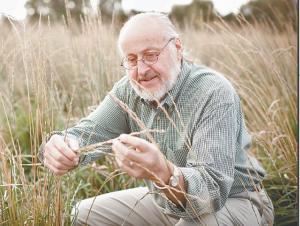Perennial “Wheat” Farm-Tested In 2015
 ✖  |
“Two northern Minnesota farmers and myself are part of this project, testing the first commercially grown perennial wheatgrass,” says Richard Magnusson of Roseau, Minn. “It’s called Kernza and yields are inching up each year. The crop can also provide plenty of forage for spring and fall grazing.”
Dr. Don Wyse, an agronomist at the University of Minnesota, thinks Kernza wheatgrass will yield more than annual wheat within a few years. “We already have a line that yields 40 percent of spring wheat when grown in wide row spacings,” he says.
A big advantage of perennial wheat over annual wheat, according to Wyse, is its root system. Kernza roots are dense and can grow to depths of 10 ft., helping survive droughts.
Lee DeHaan at the Land Institute in Kansas, a partner in the breeding program, says there’s still a lot to be learned about Kernza. One of the big challenges, he says, is stem strength. The crop grows more like grass than grain and produces a thick stand that tends to lodge. Hence, researchers are studying a variety of row spacings – up to 36 in. - to see if wider rows will produce thicker stems that will stand better.
Research at the University of Minnesota, the other partner in the project, has also identified a dwarf strain of Kernza that may lodge less, but yields from the dwarf plants so far are not equal with the non-dwarf plants.
Carmen Fernholz of Madison, Minn. is growing Kernza as part of the testing program and says the crop is ideal for northern Minnesota, where spring flooding can often force delays in spring seeding. “A lot of years, it’s hard to get the crop in the ground, so a perennial wheat crop makes a lot of sense, both for grain production and for fall grazing by cattle.” Wyse adds that Kernza can be grazed much like cattle producers graze winter wheat in the Plains states. “The crop can grow to 5 ft. tall, so it definitely produces a lot of biomass.”
The future of Kernza will depend much on how the grain is adopted by the food industry and consumers, according to Wyse. “I’ve eaten pancakes, muffins and sourdough bread made from Kernza, and they’ve tasted fine,” he says. “My guess is that a 50/50 mix of Kernza and wheat flour will become a popular product for baking bread, cookies, cakes, muffins, and so on.”
Kernza is a registered trademark of The Land Institute.
Contact: FARM SHOW Followup, Donald Wyse, Dept. of Agronomy and Plant Genetics, University of Minnesota, 411 Borlaug Hall, 1991 Upper Buford Circle, St. Paul, Minn. 55108 (ph 612 625-7064; wysex001@umn.edu).

Click here to download page story appeared in.
Click here to read entire issue
Perennial “Wheat” Farm-Tested In 2015 CROPS Miscellaneous “Two northern Minnesota farmers and myself are part of this project testing the first commercially grown perennial wheatgrass ” says Richard Magnusson of Roseau Minn “It’s called Kernza and yields are inching up each year The crop can also provide plenty of forage for spring and fall grazing ” Dr Don Wyse an agronomist at the University of Minnesota thinks Kernza wheatgrass will yield more than annual wheat within a few years “We already have a line that yields 40 percent of spring wheat when grown in wide row spacings ” he says A big advantage of perennial wheat over annual wheat according to Wyse is its root system Kernza roots are dense and can grow to depths of 10 ft helping survive droughts Lee DeHaan at the Land Institute in Kansas a partner in the breeding program says there’s still a lot to be learned about Kernza One of the big challenges he says is stem strength The crop grows more like grass than grain and produces a thick stand that tends to lodge Hence researchers are studying a variety of row spacings – up to 36 in - to see if wider rows will produce thicker stems that will stand better Research at the University of Minnesota the other partner in the project has also identified a dwarf strain of Kernza that may lodge less but yields from the dwarf plants so far are not equal with the non-dwarf plants Carmen Fernholz of Madison Minn is growing Kernza as part of the testing program and says the crop is ideal for northern Minnesota where spring flooding can often force delays in spring seeding “A lot of years it’s hard to get the crop in the ground so a perennial wheat crop makes a lot of sense both for grain production and for fall grazing by cattle ” Wyse adds that Kernza can be grazed much like cattle producers graze winter wheat in the Plains states “The crop can grow to 5 ft tall so it definitely produces a lot of biomass ” The future of Kernza will depend much on how the grain is adopted by the food industry and consumers according to Wyse “I’ve eaten pancakes muffins and sourdough bread made from Kernza and they’ve tasted fine ” he says “My guess is that a 50/50 mix of Kernza and wheat flour will become a popular product for baking bread cookies cakes muffins and so on ” Kernza is a registered trademark of The Land Institute Contact: FARM SHOW Followup Donald Wyse Dept of Agronomy and Plant Genetics University of Minnesota 411 Borlaug Hall 1991 Upper Buford Circle St Paul Minn 55108 ph 612 625-7064; wysex001@umn edu
To read the rest of this story, download this issue below or click
here to register with your account number.







